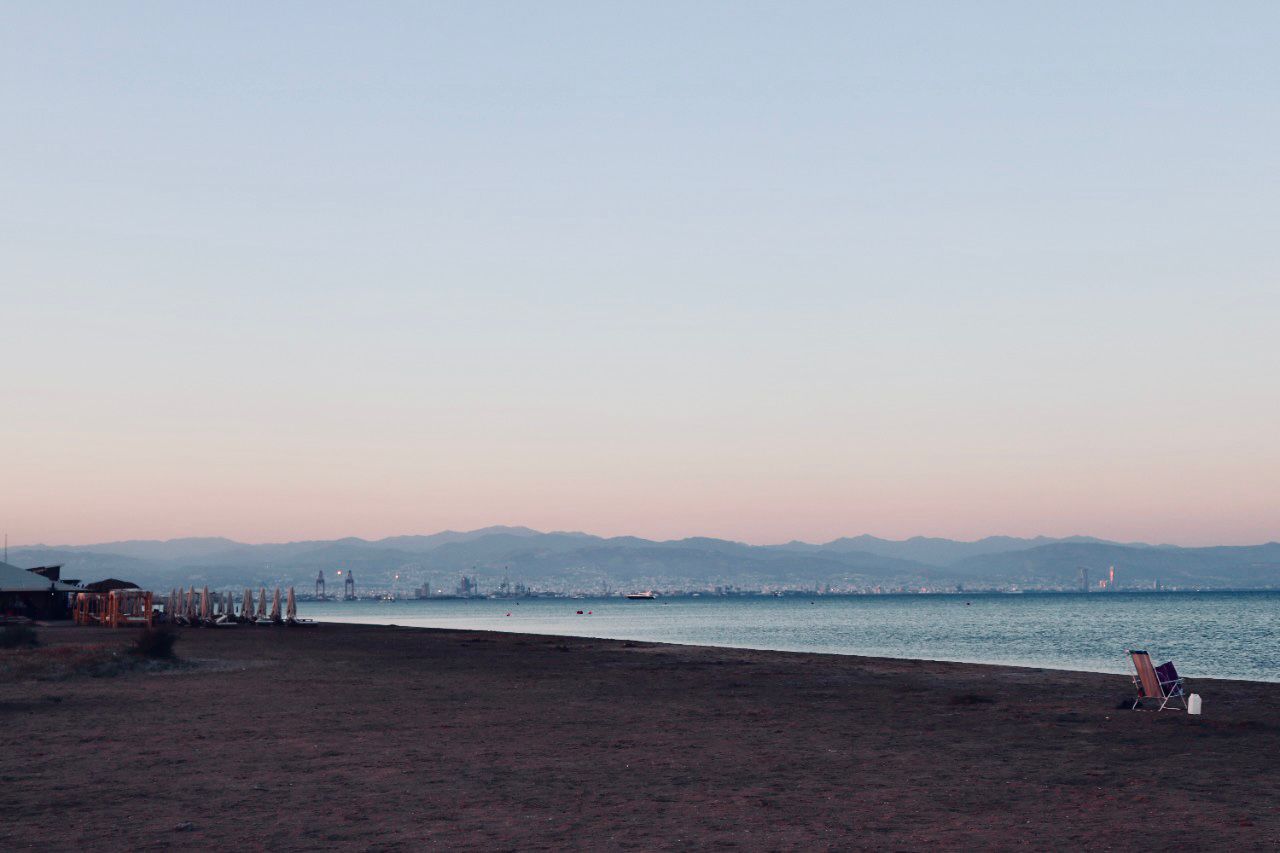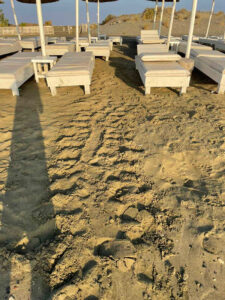It is possible for people and turtles to co-exist
By Panagiotis Georgiou
Lady’s Mile is a 5km long beach with exceptional ecological value, that supports a plethora of plants and animals. Located no more than 15 minutes away from Limassol city centre, it is an easy escape from the overpopulated, busy streets for both locals and tourists.
It is said that the Lady’s Mile beach got its name from one of the British governors, during British rule, who used to exercise his horse ‘Lady’ along the beach. Others prefer to use another name for the beach, that of Aplostra beach. Today Lady’s Mile or Aplostra is known for its sandy, shallow waters, and picturesque coastline. It is also part of a dynamic, mosaic landscape, which contains a variety of habitats, perfect for supporting biodiversity.
The sandy beaches of Lady’s Mile are not just a holiday destination but also a biodiversity hotspot. Amongst others, it is a nesting ground for sea turtles, Caretta caretta (Loggerhead) and the Chelonia mydas (Green Sea turtle). Both species are legally protected under national, international and EU legislations. Since the area lies within the SBAs, the sea turtles there are protected under the Protection and Management of Nature and Wildlife Ordinance 2007, which reflects the EU Habitats Directive, forbidding any attempt to destroy or harm sea turtle nests and/or eggs.
Sea turtles, like many animals, play an important role in maintaining coral reefs and keeping the seagrass beds healthy, as well as ensuring a balance in the sensitive marine food web. Female sea turtles travel thousands of kilometres in their lifetime. A sexually mature female will visit our sandy beaches every two to three years in order to lay her eggs. A nest will take an average of 50 days to hatch. Baby turtles are phototactic and will follow the brightest light. In most cases they follow the moonlight towards the sea, but sometimes they follow streetlights or other lights coming from nearby businesses, moving away from the sea. Sea turtles are philopatric, meaning they will visit the area where they were hatched to lay their eggs once they reach maturity.

Off-road vehicle tracks centimetres from a Caretta caretta nest. Baby turtles are very sensitive to vibrations and they can cause them to hatch during the day, risking falling victim to predators or dying from the heat
There are currently renovations taking place on Lady’s Mile and there are plans to design and implement an adjustment scheme for the area with an environmentally friendly road and so on. How can one guarantee actions like the addition of sunbeds right near the sea, the removal of barricades for easy beach access, or bringing in red soil to plant invasive trees in the area will not put further pressure on sensitive species?
Oh wait, all this sounds a bit familiar. It should, since this is what we unfortunately witnessed, amongst several other illegal and environmentally harmful activities, during the summer of 2022.
Terra Cypria – The Cyprus Conservation Foundation, in collaboration with the SBA Environmental Department, monitors Lady’s Mile’s sandy beaches during nesting season (between May-August) and coordinates a team of volunteers that closely monitor the nesting grounds for sea turtle tracks as well as any activity that can disturb the turtle habitat.
With this volunteer monitoring scheme, we try to spot tracks leading to potential nests as soon as possible and inform the specialised scientific team of the SBA Environmental Department to assess the situation and protect successful nests. Every year we spot several nesting attempts, and we usually have an average of seven or eight successful nests there.
What was noticed this year was a decrease in turtle nesting attempts on the Lady’s Mile beaches. At the same time, we saw severe habitat interventions from various development activities that interfered on the nesting grounds. We also observed extensive vehicle tracks revealing a serious obstacle to nesting efforts from people driving on the beaches and perhaps compacting and even destroying nests, before they are even spotted.
Several turtle tracks showed obvious signs of disturbance. The sea turtles were moving in various directions on the beach, desperate to lay their eggs but had to go back to the water because they kept bumping into things, beach beds and other obstacles.
The main question running through our minds is whether sea turtles will have a place to come back to and nest again in the following years.
Sea turtles are very sensitive to disturbances and will abort their eggs in the water when they fail to lay them on the beach. In the case of successful hatching, only 1 in 1000 turtles survive to reach sexual maturity. So, the protection of even one nest with 50 to 150 eggs in it is of much importance. During our monitoring this nesting season at Lady’s Mile, only three turtle nests were located.
Human presence in the area is very noticeable. No one expects that the area will not been visited by people, especially during summer months. As stated above Lady’s Mile is a well-known and extremely beautiful beach which receives thousands of visitors throughout the year and especially during the summer.
However, it is of great importance when visiting such an area to know about and recognise its importance and leave nothing behind except your footprints. Litter on the beach and in the broader area, driving off the designated roads, parking on sensitive sand dunes, which amongst others are home to one of the most endangered lizards in Cyprus, the Schreiber’s fringe-fingered lizard or Acanthodactylus schreiberi, are some of the activities we should not be witnessing in this sensitive area.
Biodiversity and its natural habitats have to be taken into serious consideration when developments take place in an area, whether these are road improvements, restaurant renovations or anything else. Healthy and complex ecosystems are the Earth’s natural mechanism to mitigate and adjust to climate change and support human life. Sustainable developments on sensitive wetlands, such as the Lady’s Mile, can enhance a visitor’s experience while at the same time safeguarding successful nesting and reproduction of sea turtles.
Here are a few rules for visiting Lady’s Mile beach that help sea turtles:
- Never disturb or move protective cages around nests
- Do not take dogs on the beach (even if they are on a lead)
- Do not camp on the beach
- Do not have bonfires
- Always collect rubbish
- Never use a vehicle of any kind on the beach
- Never disturb or touch turtles or hatchlings
- In case of an injured turtle or possible nest disturbance call 1443.
Coming to conservation actions and the protection of the Lady’s Mile and its biodiversity, Terra Cypria led a two-year long project, which started in October 2020, with the main goal being to restore Mediterranean wetland of utmost importance for biodiversity. The project is called MedIsWet and is run in collaboration with SBA authorities and the Limassol and the Sewage Board of Limassol-Amathous. Some of the core actions carried out were the removal of 400 cubic metres of garbage from sensitive areas, the destruction of motocross tracks illegally created in the area, and the blockage of uncontrolled access for cars and the public within the sensitive areas of the Salt Lake using rock boulders.
Further access management actions will be carried out during another three-year long Darwin Plus project called ‘Habitat restoration and wise use for Akrotiri and Cape Pyla’ led by BirdLife Cyprus and with Terra Cypria, the SBA Environmental Department and the RSPB as partners. This action will map sensitive wildlife sites around Lady’s Mile and identify ways to further reduce human disturbance to key sensitive areas by restricting illegal dirt road access.
Humans and sea turtles can very easily co-exist. What we all need to understand and incorporate into our daily lives and mentality is respect for all forms of life and realise that without healthy ecosystems the future of our children and grandchildren faces imminent threat. Some small, simple actions by everyone can contribute dramatically to the long-term survival of our environment, including Lady’s Mile and the broader Akrotiri Wetlands.
Panagiotis Georgiou is conservation and communication officer at Terra Cypria – The Cyprus Conservation Foundation. He holds a Bachelor’s degree in Zoology and a Master’s degree in Conservation Biology.
Do you want to become a Terra Cypria supporter? Click here and help them strengthen their voice for more environmental and sea turtle protection actions in Cyprus. You can also follow their work on Facebook and Instagram








Click here to change your cookie preferences